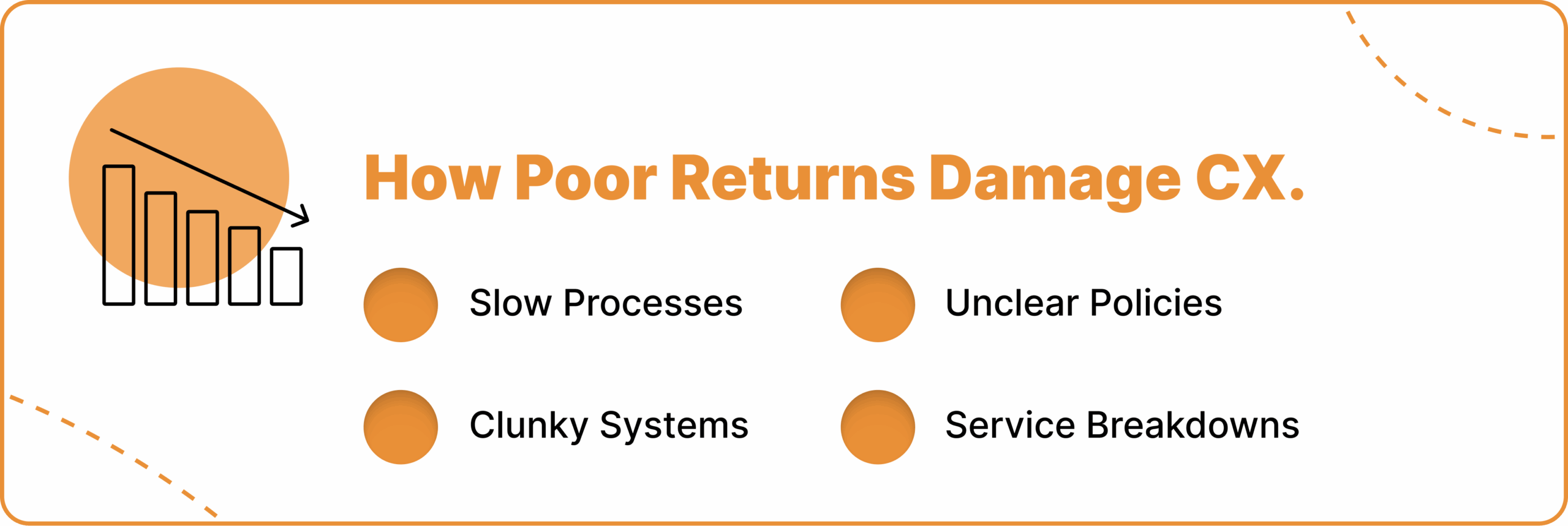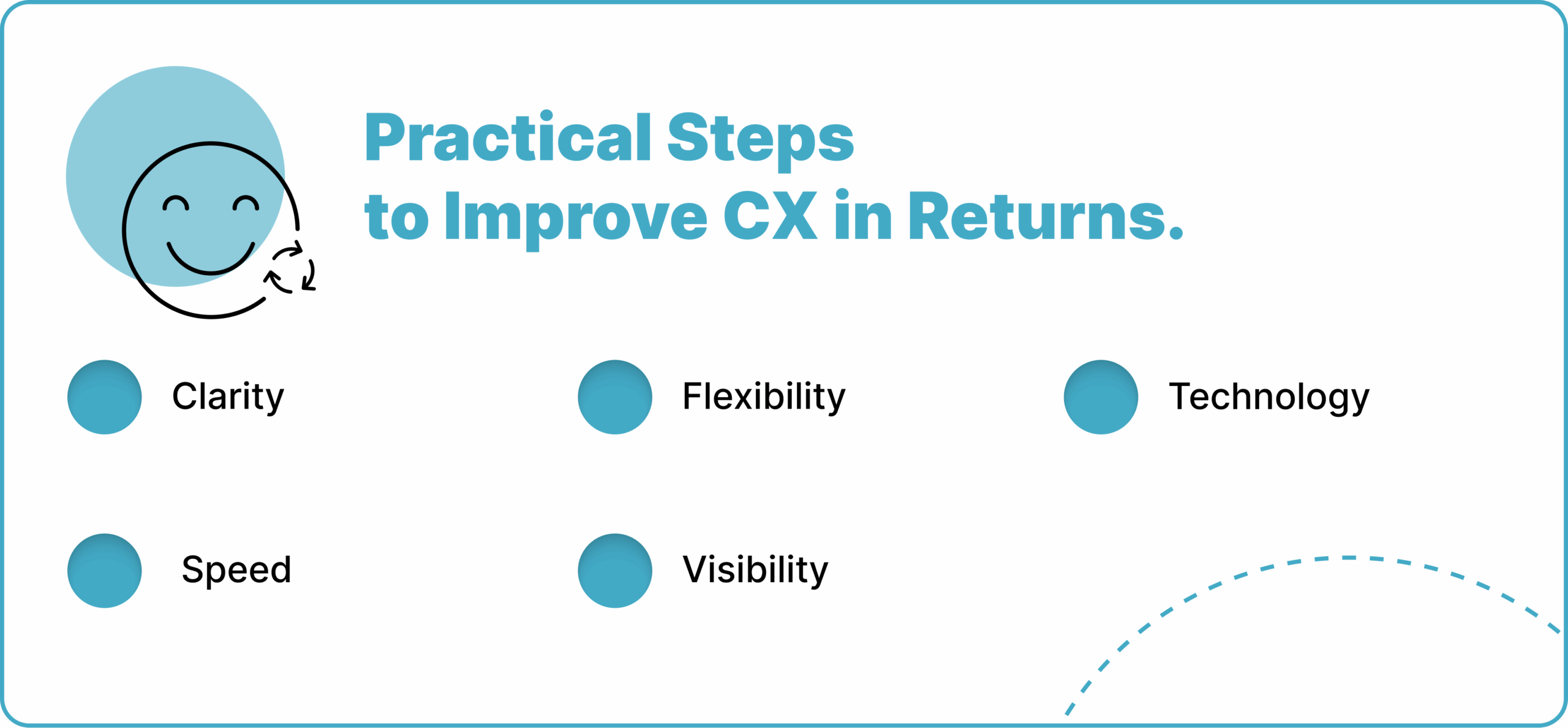The Customer Experience (CX) Cost of Getting Returns Wrong

Retailers typically spend a significant amount to acquire new buyers and ensure a successful customer experience. If you ask the average retailer, marketing campaigns, promotions, and product launches are all critical levers for attracting buyers. But many of them forget that a slow or clunky returns process can undo all that investment within a very short amount of time.
A poor return is not a back-office issue; it is a customer experience failure. And it weakens brand trust, cuts into revenue, and lowers the Net Promoter Score (NPS). But companies often overlook this reality. They perfect the forward logistics that deliver goods, but stumble on the reverse logistics that bring them back. That imbalance creates frustration for customers and long-term damage for businesses.
Why Returns Are Central to Customer Experience
Returns are not just a nuisance or a hassle that you have to deal with reluctantly. If you offer returns, then they are a core part of the customer journey. Research from Narvar shows that 92% of consumers are more likely to make a repeat purchase if returns are easy. And only 29% will return if the process is hard. Such a significant gap suggests that customer satisfaction depends as much on returns as it does on making the sales process as seamless as possible.
Returns are one of the last customer interactions in the purchase cycle. If the experience is poor, your customers will leave with a negative memory of the brand. However, if you make the necessary investments to ensure it is smooth, they will feel valued and are more likely to make a repeat purchase. Customer experience management cannot ignore returns, because customer relationships depend on every step of the journey.
How Poor Returns Damage CX

Slow, clunky, or unclear returns erode customer trust and loyalty. And every delay or error leaves customers feeling ignored and undervalued.
1. Slow Processes
If you can deliver a product to customers within 2 days, you should be able to process returns within a similar time frame. Anything short of that creates frustration. Customers want their refunds processed as soon as possible, typically within a few days. When it is taking too long, they question the company’s ability to deliver service quality. Long delays also create cash flow stress for customers, especially after high-value purchases.
2. Clunky Systems
Many industries still rely on paper slips, manual approval steps, or call-center bottlenecks to process their product returns. The problem with such outdated methods is that they make the entire process tedious and also create errors in tracking returned items. More alarming is that they increase reverse logistics risk by misplacing goods or failing to confirm receipt. Customers often feel trapped in a broken process, which negatively impacts customer experience scores and repeat sales.
3. Unclear Policies
Customers often face vague rules or hidden fees. For example, a buyer may be expecting free returns only to discover that shipping costs are deducted from the refund. Surprises like these damage brand trust and weaken long-term loyalty. They also spark negative reviews that reach new customers and deter future business.
4. Service Breakdowns
Poor communication and a lack of tracking systems can compound frustration in the customer experience. Customers want visibility into the location of their returned items and when refunds will be processed. Without updates, they assume the worst and share their disappointment, which can be damaging to the brand image.
A single bad return can turn a loyal customer into a critic. A report from PwC found that 32% of customers stop doing business with a brand after one bad experience. In retail, that means not just one lost sale but a lifetime of lost revenue.
Quantifying the CX Cost of Return Errors
The damage from poor returns is measurable because it impacts sales volume, NPS, and long-term loyalty.
1. Lost Revenue
Research from Pitney Bowes shows that 54% of customers cease purchasing from a retailer after experiencing a poor return experience. This sort of turnover raises acquisition costs because businesses must replace lost customers with new ones. The cost of finding new customers is often five times higher than retaining existing ones.
2. Repeat Purchase Loss
The average customer who has a bad return experience is less likely to make a purchase again. Over time, that will translate into weaker sales volume, lower market share, and reduced long-term success.
3. Customer Loyalty Impact
In the retail world, loyalty is fragile. Customers who once valued a brand can lose faith overnight. And it can be worse when returns feel unfair. This creates recurring issues in loyalty programs and long-term customer relationships.
When measured over time, poor returns processes can cut millions from revenue streams. They erode customer journeys, break customer trust, and limit a company’s ability to compete.
Reverse Logistics Risk and Its Hidden CX Impact
Errors in the reverse logistics processes, such as lost items, delays, or damaged goods, directly harm customer satisfaction because reverse logistics is deeply tied to customer experience.
1. Delays: When reverse logistics teams take too long to process returned items, refunds are delayed. Customers see this as poor service quality, not a warehouse issue.
2. Lost items: If inventory teams misplace returned goods, customers are left without refunds, which can destroy brand trust and create disputes that drain service teams.
3. Damaged goods: Returned items that are resold without inspection can disappoint the next buyer, creating new negative experiences.
Each of these risks may appear to be internal supply chain challenges, but they are actually disguised as customer interactions. Reverse logistics risk becomes customer experience risk. The faster companies make that connection, the faster they can protect revenue and loyalty.
Contrary to popular opinion, the reverse supply chain is not invisible to customers. Every breakdown is felt at the customer’s end of the chain.
Practical Steps to Improve CX in Returns

Retailers can enhance the customer experience by addressing weaknesses in the returns process. Small changes in speed, clarity, and visibility can go a long way and deliver significant gains in capturing customers’ loyalty to the brand.
1. Clarity: Write returns policies in plain language and avoid hidden costs. Transparency will reduce disputes and build trust.
2. Speed: Process refunds quickly, aiming for three to five days. Fast service increases customer satisfaction and reduces customer anxiety and complaints.
3. Flexibility: Offer multiple return options. It could be drop-off points, home pickup, and prepaid labels. The goal is to meet customer expectations across various industries.
4. Visibility: Add tracking systems so customers can follow returned items in real time. This also helps reduce anxiety and build confidence.
5. Technology: Use returns management platforms like ReverseLogix to reduce errors, manage inventory better, and cut reverse logistics risk.
These steps are not only about service—they are about business. Faster and clearer returns reduce costs, protect revenue, and create competitive advantage.
Leverage ReverseLogix to Enhance Customer Experience
Returns are not afterthoughts. They are central to customer experience. Slow, clunky, or unclear returns damage brand trust, lower NPS, and reduce long-term loyalty. They cause lost revenue, recurring issues, and weaker customer relationships.
However, you can modernize your returns processes with ReverseLogix and protect more than just refunds. You can protect the trust of your customers. By leveraging the ReverseLogix RMS application to build returns into customer experience management, your company can improve service quality, reduce costs, and secure long-term success.
Frequently Asked Questions (FAQs)
Returns are often the last stage in a customer journey, which means they shape the final impression of a brand. If the process is slow or unclear, customers feel undervalued and leave with a negative experience. Research shows that easy returns boost customer satisfaction, increase customer loyalty, and strengthen brand trust, while poor returns damage long-term relationships and revenue.
Bad returns cost more than refunds. They reduce repeat sales and weaken long-term loyalty. A negative experience can lower net promoter score, cutting into referral value and lifetime revenue. Since it costs more to acquire new customers than to retain existing ones, poor returns inflate marketing costs while eroding sales volume and profit.
Reverse logistics involves moving returned items back through the supply chain. If it is slow, clunky, or error-prone, it directly affects customers’ experience. Delayed refunds, lost items, or damaged goods create frustration. Customers don’t see these as warehouse issues—they see them as poor service quality. Companies that manage reverse logistics well reduce risk, build trust, and improve overall customer experience management.
Companies can improve returns by focusing on clarity, speed, and visibility:
– Write simple policies that set clear customer expectations.
– Process refunds quickly to build confidence.
– Offer flexible return options to meet diverse customer needs.
– Provide tracking systems so customers can see where their returned items are.
– Invest in solutions like returns management platforms to reduce errors and improve inventory management.
These changes strengthen customer relationships, improve service quality, and deliver competitive advantage.
Brand loyalty depends on trust and consistency. A customer may love a product, but if returning it is painful, they are less likely to buy again. Negative experiences spread quickly through reviews and social media, lowering a brand’s ability to attract new business. On the other hand, easy returns build trust, increase long-term loyalty, and give companies an edge in industries where customer experience is increasingly important.
